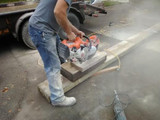How to Set Up a Temporary Work Platform in Tight Spaces
Sometimes the jobsite isn’t wide open. Whether you're working in a narrow hallway, alleyway, stairwell, or even inside an industrial facility with limited clearance, tight spaces present real challenges when it comes to setting up a safe and effective work platform.
Here’s a guide to help you build a temporary work platform that’s stable, efficient, and fits the job—no matter how cramped the space.
1. Assess the Space and Scope of Work
Before you start stacking materials, take a moment to evaluate:
-
The width and length of the available space
-
Overhead clearance
-
The weight the platform will need to support (tools, materials, workers)
-
Entry and exit access for safety
Tight spaces often require custom solutions, so knowing your constraints up front will guide your equipment choices.
2. Choose the Right Equipment
For compact areas, your best bets are:
-
Aluminum Scaffold Planks – Lightweight, strong, and can span between surfaces like ladders or low-profile frames.
-
Mini Scaffolding Units – Compact mobile scaffolds that are easy to maneuver in hallways or around corners.
-
Adjustable Ladder Jacks – Ideal when paired with extension ladders to create a raised platform over narrow areas.
-
Pump Jack Systems – Slim profile, easy to raise and lower, and can be set up with minimal footprint.
Look for systems that can be adjusted vertically and horizontally to fit into unconventional spaces.
3. Stabilize Your Foundation
Just because it’s a small space doesn’t mean you can compromise on stability. Make sure:
-
All feet are securely placed on solid ground (or use base plates or levelers if the surface is uneven).
-
Outriggers or braces are used if available.
-
Planks are secured and won’t shift under load.
In tight spaces, even minor wobbling can be dangerous. Always check for level and lock components in place.
4. Maximize Safety in Confined Areas
Working in tight spaces often means limited movement. Here’s how to reduce risk:
-
Install guardrails when possible, especially on platforms over 6 feet high.
-
Use slip-resistant planking.
-
Keep the work area free of clutter—tight spaces amplify trip hazards.
-
Make sure there’s always a clear path to exit the platform in case of emergency.
Bonus tip: Communicate clearly with your crew. In close quarters, one unexpected movement can impact everyone.
5. Make It Easy to Move and Adjust
Tight spaces often require you to reposition frequently. Use components that are:
-
Modular and lightweight
-
Equipped with casters or wheels (lockable for safety)
-
Designed for tool-free assembly
Pump jacks and small rolling scaffold towers make adjustments a breeze without taking up extra space.
Final Thoughts
Setting up a temporary work platform in a tight space is all about balance—literally and figuratively. With the right tools, careful planning, and a safety-first mindset, you can work efficiently even in the most confined spots.
At Southwest Scaffolding, we offer a wide range of scaffolding systems, planks, ladder jacks, and accessories that are perfect for tight jobsites. If you're not sure what will work best for your project, reach out—we’re here to help.
Recent Posts
-
The Rise of the Mega-Job: Why Projects Keep Getting Bigger
From sprawling data centers to multi-tower apartment complexes, construction projects aren’t just g …Oct 21st 2025 -
The Most Overlooked Jobsite Hazards (That Cause the Most Injuries)
When people think of construction hazards, they picture the big ones — scaffolding falls, heavy equi …Oct 21st 2025 -
Why Contractors Secretly Love Rain Days (and Secretly Hate Them Too)
Every contractor has a love-hate relationship with rain. On one hand, it means a break from the grin …Oct 21st 2025




